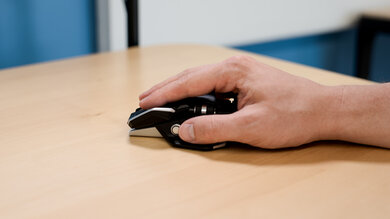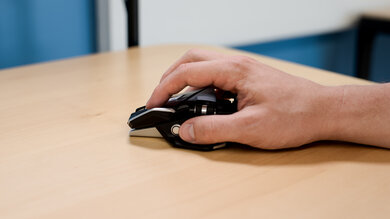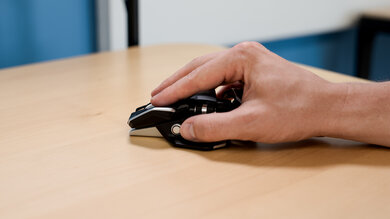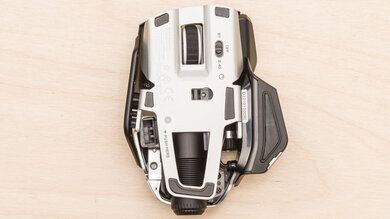The Mad Catz R.A.T. DWS is one of the more premium models in the R.A.T. lineup, and it's the only wireless option in the series. It feels well-built, but the mouse feet are very thin and feel cheap. It has a moveable palm section that lets you adjust the length of the mouse to your needs, and it comes with alternative right side panels and a pinky rest to change the look and feel. Performance-wise, it has a wide CPI range, a CPI you can adjust in increments of 100, and a very low lift-off distance. It has good click latency via its USB receiver, although it isn't as low as other models. Unfortunately, it's very heavy, and the mouse can only obtain a polling rate of 100Hz when connected via Bluetooth. Also, note that you need to store the receiver in the mouse for the Bluetooth to work.
Our Verdict
The Mad Catz R.A.T. DWS is excellent for office use. It's universally well-suited for all hand sizes and grip types thanks to its moveable palm section that lets you adjust the length to your needs. Also, it comes with a pinky finger rest, along with two different side panels. There are many programmable buttons, and it has a thumb wheel on its left side, but it's awkwardly placed. Unfortunately, its scroll wheel can't unlock for free scrolling, but it does have L/R tilt buttons, which are rare on most gaming mice.
-
Can connect via USB receiver and Bluetooth.
-
Adjustable length; suitable for all hand sizes and grip types.
-
Scroll wheel has L/R tilts.
-
Programmable thumb wheel.
-
Scroll wheel can't unlock for free scrolling.
The Mad Catz R.A.T. DWS is okay for FPS gaming. It has low click latency when used with its USB receiver, although it isn't as low as other gaming options. It has a very low lift-off distance, a wide CPI range, and a CPI you can adjust in increments of 100. You can reprogram all of its buttons, and it has a moveable palm section that lets you adjust the length to your hand size. Unfortunately, it's very heavy, and its mouse feet are thin and feel cheap. Note that you can only use the mouse wirelessly.
-
Good click latency with USB receiver.
-
Very low lift-off distance.
-
Adjustable length; suitable for all hand sizes and grip types.
-
Very heavy.
-
Can only be used wirelessly.
-
Mouse feet are very thin and feel cheap.
The Mad Catz R.A.T. DWS is very good for MMO gaming, but it doesn't have nearly as many side buttons as a dedicated MMO gaming mouse. On the bright side, you can reprogram all of the buttons it does have, including the thumb wheel. It has low click latency, a very low lift-off distance, and a broad CPI range with a CPI you can adjust in increments of 100. It's universally well-suited for all hand sizes and grip types thanks to its moveable palm section that lets you adjust the length to your needs. Also, it comes with a pinky finger rest, along with two different side panels. Note that you can only use the mouse wirelessly.
-
Good click latency with USB receiver.
-
Very low lift-off distance.
-
Adjustable length; suitable for all hand sizes and grip types.
-
Doesn't have as many buttons as a dedicated MMO mouse.
-
Can only be used wirelessly.
The Mad Catz R.A.T. DWS is a poor choice for fans of ultra-light gaming mice because it's very heavy. Also, its mouse feet are very thin and feel cheap. The click latency is somewhat low when used with its USB receiver, but we don't recommend using Bluetooth for gaming since the latency is very high, and the polling rate locks at 100Hz. Note that you can only use the mouse wirelessly.
-
Good click latency with USB receiver.
-
Very low lift-off distance.
-
Very heavy.
-
Can only be used wirelessly.
-
Mouse feet are very thin and feel cheap.
The Mad Catz R.A.T. DWS is very good for travel, but it's bulky and heavy, and it may not fit in most laptop cases. That said, it feels well-built, and you can use it via its USB receiver or over Bluetooth; however, the receiver needs to be stored in the mouse for the Bluetooth to work. Unfortunately, not all of the buttons work on macOS.
-
Can connect via USB receiver and Bluetooth.
-
Adjustable length; suitable for all hand sizes and grip types.
-
Very heavy.
- 8.5 Office/Multimedia
- 6.7 Video Games (FPS)
- 8.0 Video Games (MMO)
- 4.7 Ultra-Light Gaming
- 8.1 Travel
- Updated Sep 02, 2022: We've fixed an error in the Shape section where we had previously listed incorrect Width, Grip Width, and Length measurements. The Volume result in the Portability section has also changed as a result. Additionally, we've adjusted our 3D scan model, which wasn't properly aligned.
- Updated Aug 25, 2021: Review published.
- Updated Aug 13, 2021: Early access published.
- Updated Jun 21, 2021: Our testers have started testing this product.
- Updated Jun 14, 2021: The product has arrived in our lab, and our testers will start evaluating it soon.
- Updated May 04, 2021: We've purchased the product and are waiting for it to arrive in our lab.
Differences Between Sizes And Variants
We tested the Mad Catz R.A.T. DWS in black, and there are no other color variants. You can see our unit's label here.
Compared To Other Mice
The Mad Catz R.A.T. DWS is one of Mad Catz' more premium models in the R.A.T. lineup, and it's the only wireless model in this series. It has an adjustable palm section that shortens or lengthens the size of the mouse, as well as swappable right side panels for a pinky rest or different grip textures. Like other mice in its lineup, it has an angular design with plastic plates that form the mouse's body instead of the usual solid shell you see on typical mice. Unfortunately, it's very heavy, and its click latency isn't as low as other gaming mice.
For other options, see our recommendations for the best mice, the best gaming mice, and the best wireless gaming mice.
The Mad Catz R.A.T. 8+ and the Mad Catz R.A.T. DWS are more premium models in the R.A.T. lineup, but the DWS is the only wireless model. The 8+ is lighter, and it has a lower minimum CPI, and you can adjust the set CPI more precisely in increments of 50 instead of the DWS' 100. Also, its maximum polling rate is higher. On the other hand, you can use the DWS over a USB receiver or Bluetooth, and its click latency over the receiver is lower than the 8+'s wired latency. Both come with interchangeable parts to modify the feel and look of the mouse, making them suitable for all hand sizes regardless of grip type.
The Mad Catz R.A.T. 4+ is a mid-range mouse in the Mad Catz R.A.T. lineup, while the Mad Catz R.A.T. DWS is the only wireless model in the lineup. The R.A.T. 4+ is wired-only and significantly lighter. It also has a more precisely adjustable CPI. On the other hand, the R.A.T. DWS feels sturdier and connects wirelessly either with its USB receiver or via Bluetooth. Additionally, it has several interchangeable pieces that alter the look and feel of the mouse, a mouse wheel with L/R tilt buttons, and a thumb wheel. Performance-wise, it has lower click latency when connected with its USB receiver. However, It has extremely high click latency when connected via Bluetooth.
The Razer Viper Mini is an incredible ultra-light wired gaming mouse, while the Mad Catz R.A.T. DWS is a decent wireless-only gaming mouse. The Razer is much lighter, its mouse feet glide significantly more smoothly, and its click latency is much lower. Comparatively, the Mad Catz has a wider CPI range, a lower lift-off distance, and a more consistent sensor. Also, it has many interchangeable and adjustable parts to better fit your hand size, regardless of grip type. You can use it via USB receiver and Bluetooth, but the latency over Bluetooth is much too high for gaming.
The Logitech MX Anywhere 2S and Mad Catz R.A.T. DWS are wireless mice designed for different purposes. The Logitech is a travel-friendly office mouse that's lightweight and low-profile, and its scroll wheel can unlock for free scrolling. On the other hand, the Mad Catz is a wireless gaming mouse with interchangeable parts that change the look and feel of the mouse. Since it's geared towards gaming, it has more programmable buttons, a lower lift-off distance, and a much higher polling rate. It uses an AA battery while the Logitech uses an internal rechargeable one.
The Logitech G502 LIGHTSPEED and the Mad Catz R.A.T. DWS are both wireless gaming mice, but the Logitech performs better overall. The Logitech has a wider CPI range, with a CPI that you can adjust more precisely, and its click latency is lower. The Logitech's scroll wheel can unlock for free scrolling, which is great if you intend to use it for office work. On the other hand, the Mad Catz has Bluetooth support, which the Logitech lacks, and it has a thumb wheel for side-scrolling. Also, it has many moveable and interchangeable parts to adjust the look and size of the mouse, making it suitable for any hand size regardless of grip type.
The Logitech G502 HERO is a good wired gaming mouse, while the Mad Catz R.A.T. DWS is a decent wireless-only gaming mouse. Overall, the Logitech is better thanks to its wider CPI range, more precisely adjustable CPI, and much lower latency. It has more programmable inputs, and you can set a HyperShift button for more layers. Also, its customization software is available on both Windows and macOS, while the Mad Catz software is available on Windows only. On the other hand, you can use the Mad Catz via USB receiver or Bluetooth, but the Bluetooth latency is too high for gaming. The Mad Catz has a thumb wheel, and it comes with both adjustable and interchangeable parts to better fit your hand size.
Test Results
The Mad Catz R.A.T. DWS has an adjustable palm rest that changes the length of the mouse. With the palm rest fully extended, the mouse is 5.0" (125.8mm), but you can adjust it to be as short as 4.4" (112.1mm). It also comes with alternate right side panels that change the width of the mouse. With the winged pinky rest, the mouse is 4.3" (108.7mm), and with the smooth or textured plastic cover, it's 3.4" (87.7mm).
This mouse comes with a GP Alkaline AA battery that weighs 23.33g. However, we perform our tests using our own generic batteries as per our methodology. The battery we used is an Amazon Basics rechargeable AA battery that weighs 27.51g.
While this isn't written in the manual, we discovered that you need to store the USB receiver inside the Mad Catz R.A.T. DWS to activate the Bluetooth. Mad Catz claims the battery on a single charge can last about 200 hours when using the receiver and 300 hours when using Bluetooth, but we don't test this.
The polling rates available on the Mad Catz R.A.T. DWS are 125Hz, 250Hz, 500Hz, and 1000Hz. However, it can only obtain a polling rate of 100Hz when connected via Bluetooth.
You can reprogram all buttons on the Mad Catz R.A.T. DWS, including the top right side button, the up/down inputs of both wheels, and the L/R buttons in the top scroll wheel.
The Mad Catz R.A.T. DWS's top side button next to the left click cycles through four custom profiles by default, but since the software isn't available on macOS, you can't create profiles, rendering the button useless.













